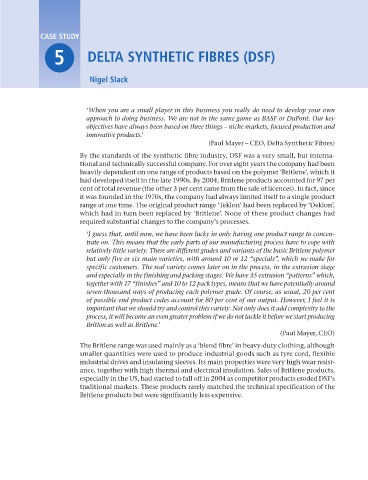Page 420 - Operations Strategy
P. 420
case study 5 • delta synthetic Fibres (dsF)
Case study
5 delta synthetic Fibres (dsF)
nigel slack
‘When you are a small player in this business you really do need to develop your own
approach to doing business. We are not in the same game as BASF or DuPont. Our key
objectives have always been based on three things – niche markets, focused production and
innovative products.’
(Paul Mayer – CEO, Delta Synthetic Fibres)
By the standards of the synthetic fibre industry, DSF was a very small, but interna-
tional and technically successful company. For over eight years the company had been
heavily dependent on one range of products based on the polymer ‘Britlene’, which it
had developed itself in the late 1990s. By 2004, Britlene products accounted for 97 per
cent of total revenue (the other 3 per cent came from the sale of licences). In fact, since
it was founded in the 1970s, the company had always limited itself to a single product
range at one time. The original product range ‘Teklon’ had been replaced by ‘Deklon’,
which had in turn been replaced by ‘Britlene’. None of these product changes had
required substantial changes to the company’s processes.
‘I guess that, until now, we have been lucky in only having one product range to concen-
trate on. This means that the early parts of our manufacturing process have to cope with
relatively little variety. There are different grades and variants of the basic Britlene polymer
but only five or six main varieties, with around 10 or 12 “specials”, which we make for
specific customers. The real variety comes later on in the process, in the extrusion stage
and especially in the finishing and packing stages. We have 35 extrusion “patterns” which,
together with 17 “finishes” and 10 to 12 pack types, means that we have potentially around
seven thousand ways of producing each polymer grade. Of course, as usual, 20 per cent
of possible end product codes account for 80 per cent of our output. However, I feel it is
important that we should try and control this variety. Not only does it add complexity to the
process, it will become an even greater problem if we do not tackle it before we start producing
Britlon as well as Britlene.’
(Paul Mayer, CEO)
The Britlene range was used mainly as a ‘blend fibre’ in heavy-duty clothing, although
smaller quantities were used to produce industrial goods such as tyre cord, flexible
industrial drives and insulating sleeves. Its main properties were very high wear resist-
ance, together with high thermal and electrical insulation. Sales of Britlene products,
especially in the US, had started to fall off in 2004 as competitor products eroded DSF’s
traditional markets. These products rarely matched the technical specification of the
Britlene products but were significantly less expensive.
Z05 Operations Strategy 62492.indd 395 02/03/2017 13:42

